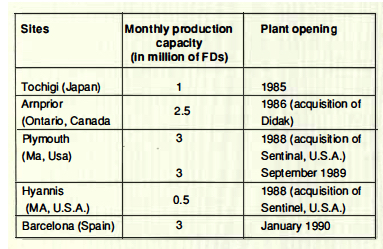History (1989): Kao Ambitions to Produce $13 Million Floppy Disks Per Month in 1990
After acquisition of Didak and Sentinel
By Jean Jacques Maleval | August 7, 2019 at 2:38 pmWith plants in Japan, the U.S. and Canada, plus a new 3.5-inch FD one in Barcelona (Spain), Kao Corporation (Tokyo, Japan) plans to reach a production of 13 million FDs a month in 1990.

“Then we will become the world’s largest manufacturer,” says the Japanese company proudly.
Actually, Kao produces 5 to 7 million 5.25-inch FDs and 7 million 3.5-inch ones a month in its different plants.
Established in 1887, Kao is a huge Japanese business with 20,000 employees worldwide, its activities cover different fields: fat and oil products, surfactants, hygiene products, hair and skin care products, cosmetics, foods, pharmaceuticals, new materials, functional polymers, fine chemicals. In its fiscal year ended on March 31, 1988, the company reported sales of ¥514 billion and a profit of ¥13.4 billion. On March 31, 1989, the company was expecting an 11% increase in its sales. All these products are manufactured in 31 plants all over the world including 13 in Japan.
The company also owns 20 R&D centers that employ about 2,000 people, which represents 10% of its staff.
Basic component producing is what brought Kao into magnetic support manufacturing. In 1955, the Wakayama (Japan) plant began producing lubricants, surface-active subsystems and dispersing agents for magnetic tapes.
Several patents were registered on components used in diskette manufacturing.
Kao opened its first FD plant in 1985 in Tochigi (Japan). In 1986, Kao acquired the Canadian company Didak (that became Kao-Didak Ltd.) and invested $40 million in an automatic manufacturing line that works full time and should produce 6 million 3.5-inch FDs starting September 1989.
Still in 1986, Kao entered the US for the first time as it opened an office in San Francisco, CA, then in Europe with one in Dusseldorf, West Germany.
Up until then, Kao produced only 5.25-inch FDDs, it began manufacturing 3.5-inch format in 1987.
Another important moment for the Japanese firm was when it acquired the American share of Sentinel Technology (U.S.A.) in 1988, and its little plant in Hyannis, MA. All its manufacturing plants produce the components for FDs, except the cookies that come from Japan.
European marketing circuit is growing larger: after an office in Barcelona, Spain, in 1987, another one was opened in London, UK, in 1988 and this year in France, in Rueil-Malmaison.
The next important option for Kao will be the opening of a new plant in Barcelona in January 1990 that should produce 3 million 3.5-inch FDs in its first year. The choice of Barcelona came from the fact that it was Kao’s first European venture, and this decision was probably taken in relation with the European project for unification in 1993, to avoid anti-dumping taxes on non-European products, that occur in the US on Japanese diskettes.
At the beginning, Kao mostly sold its diskettes to OEMs. IBM approved one its lines in Plymouth, accounts for one of its OEM customers, but it also includes another big one, Apple, that has signed an agreement with Kao-Didak this year to buy the equivalent of $5 million 2MB diskettes in the next 5 years.
“Computer technology is advancing rapidly,“, said the company. “Kao-Didak, in response to these changes, began producing 2MB diskettes this May.”
The company will be the first manufacturer in North America to produce this kind of diskettes.
For several months now, Kao has chosen to sell diskettes to distributors under its own name, and is investing a large amount of money to publicize its brand name. The Japanese R&D teams are studying production of 2-inch diskettes, already used in some Japanese laptop computers and some still-video cameras.
In this computer industry, Kao also produces magnetic recording heads and toners for laser printers.
This article is an abstract of news published on the former paper version of Computer Data Storage Newsletter on issue ≠17, published on June 1989.














 Subscribe to our free daily newsletter
Subscribe to our free daily newsletter

